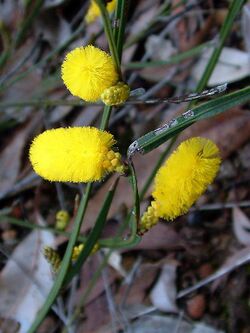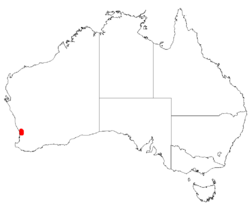Biology:Acacia anomala
| Acacia anomala | |
|---|---|

| |
| Scientific classification | |
| Kingdom: | Plantae |
| Clade: | Tracheophytes |
| Clade: | Angiosperms |
| Clade: | Eudicots |
| Clade: | Rosids |
| Order: | Fabales |
| Family: | Fabaceae |
| Subfamily: | Caesalpinioideae |
| Clade: | Mimosoid clade |
| Genus: | Acacia |
| Species: | A. anomala
|
| Binomial name | |
| Acacia anomala C.A.Gardner ex. Court[3]
| |

| |
| Occurrence data from AVH | |
Acacia anomala, commonly known as grass wattle is a shrub belonging to the genus Acacia. It is native to a small area along the west coast of Western Australia,[4] and is listed as a vulnerable species under the Western Australian Wildlife Conservation Act and the Commonwealth Environmental Protection Act.[1][2]
Description
The shrub has a slender rush-like habit and typically grows to a height of 0.2 to 0.5 metres (0.7 to 1.6 ft).[4] It has a multi-stemmed base with narrowly winged upper stems. There are few to no phyllodes which have a linear to narrowly elliptic shape and are 4 to 10 centimetres (1.6 to 3.9 in) in length and have a width of 2 to 6 millimetres (0.08 to 0.24 in).[5] It produces yellow flowers between August and September.[4] The simple inflorescences are supported on glabrous peduncles that are 1 to 4 mm (0.04 to 0.16 in) long. The flower spikes are usually 1 to 3 cm (0.4 to 1.2 in). Seed pods form later that have a linear shape and are 5 cm (2.0 in) in length and 3 mm (0.12 in). The seeds in the pod are 2.5 mm (0.10 in) in length with an oblong shape.[5]
Taxonomy
The species was first formally described by Arthur Bertram Court in 1978 as part of the work Three new species of Acacia (Mimosaceae) from Western Australia published in the journal Nuytsia.[3] It was briefly reclassified by Leslie Pedley in 2003 as Racosperma anomalum,[6] then back to the original name in 2006, with the dispute being finally resolved in 2011.[7][8][9] (See Acacia.)
The type specimen was collected by Charles Austin Gardner and H.H.Kretchmar in 1961 between Muchea and Chittering.[5] It is very similar in appearance to Acacia applanata.[5]
Distribution
The species has a very small range, confined to an area between Chittering, Swan and Kalamunda where it grows on the slopes of the Darling Range in lateritic soils.[4] It is mostly found as part of Eucalyptus woodland communities.[5]
See also
References
- ↑ Jump up to: 1.0 1.1 Government Gazette(2018) Wildlife Conservation (Rare Flora) Notice 2017.Government Gazette, 16 January 2018, p.185 Retrieved 13 June 2018.
- ↑ Jump up to: 2.0 2.1 SPRAT (Species Profile and Threats database): Acacia anomala. Retrieved 16 November 2018.
- ↑ Jump up to: 3.0 3.1 Court, A.B. (1978) Three new species of Acacia (Mimosaceae) from Western Australia. Nuytsia 2(4) 168-177.
- ↑ Jump up to: 4.0 4.1 4.2 4.3 "Acacia anomala". FloraBase. Western Australian Government Department of Parks and Wildlife. https://florabase.dpaw.wa.gov.au/browse/profile/3219.
- ↑ Jump up to: 5.0 5.1 5.2 5.3 5.4 "Acacia anomala". World Wide Wattle. Western Australian Herbarium. http://worldwidewattle.com/speciesgallery/anomala.php.
- ↑ Pedley, L. (2003). "A synopsis of Racosperma. C.Mart. (Leguminosae: Mimosoideae).". Austrobaileya 6 (3): 445–496.
- ↑ "The Acacia debate". IBC2011 Congress News. http://worldwidewattle.com/infogallery/nomenclature/nameissue/melbourne-ibc-2011-congress-news-tuesday-26-july.pdf.
- ↑ Smith, Gideon F.; Figueiredo, Estrela (2011). "Conserving Acacia Mill. with a conserved type: What happened in Melbourne?". Taxon 60 (5): 1504–1506. doi:10.1002/tax.605033.
- ↑ "Acacia anomala C.A.Gardner ex Court". Atlas of Living Australia. Global Biodiversity Information Facility. https://bie.ala.org.au/species/http://id.biodiversity.org.au/node/apni/2914483#names.
External links
Wikidata ☰ Q9562204 entry
 |


